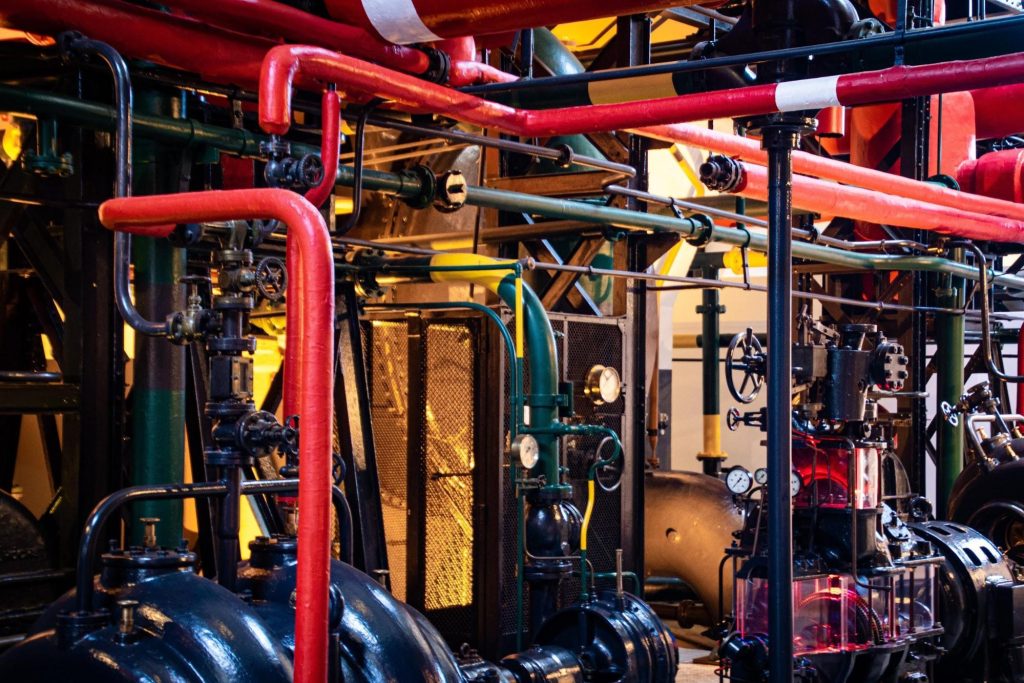https://www.pexels.com/photo/red-and-gray-industrial-machinery-2569842/
One type of valve that can do all these things is called a butterfly valve, which operates with a quarter-turn rotary motion. A shaft turns the butterfly valve’s disc. The disk totally stops the line when the butterfly valve is closed. The disc is perpendicular to the fluid flow with the butterfly valve fully open.
The valve can be fully closed or opened by rotating the handle a full ninety degrees. A “gearbox” is commonly used to connect the handwheel to the stem of a large butterfly valve through gears. This streamlines valve functioning but slows things down a bit.
Common applications of Butterfly Valves in the industry are discussed below. They are also essential components in fluid systems built by industrial-sized tanks construction experts, where managing pressure and flow is crucial for both safety and efficiency.
Common applications of Butterfly Valves in the industry are discussed below:
Uses of Butterfly Valves
The scope of applications for butterfly valves is vast. Butterfly valves are commonly used in the following areas: water and wastewater treatment; slurry services; fire protection; air and gas supply; vacuum services; lubrication system; chemical and oil industries; fuel handling systems; power generation; compressed air and gas services; steam services; food and pharmaceutical processing; marine systems; and sanitary valves.
To summarize, butterfly valves can be used in:
- Constant Load Applications
- Space-Restrictive Applications
- Throttling Valves
- Applications for Butterfly Valves
As its name suggests, butterfly valves have many possible uses. They function admirably in slurry and high-volume water applications. Common uses for Butterfly valves include the following:
- Heating and cooling systems for water, air, and gases; fire suppression systems used by medical device injection molding suppliers, etc.
- Services that are similar to slurry
- Mechanical removal of air by means of a vacuum
- Water and steam at very high pressures and temperatures
- Uses for Compressed Air and Gases
Uses Apart From The Obvious
-
Use As Shut-Off Valves
When the pipe diameter is larger than about 1.5″ but smaller than about 148″, a butterfly valve is typically utilized as a shut-off valve. A better seal than a globe valve’s gate, it is bubble-tight and ideal for industrial use. When the valve is closed, it helps to prevent liquids from leaking out of the pipe.
By using a straightforward layout, this valve requires less storage space than its counterparts and weighs significantly less.
It acts as a throttling valve to regulate flow rates and can be used to completely shut off fluid flow in pipelines with large internal diameters. It is manufactured in several shapes and sizes to accommodate a variety of pressures and purposes, and its adaptable design allows it to be used in a wide variety of contexts.
-
During Construction Of Ships
Due to their reliability and longevity, butterfly valves are commonly utilized in the power generating industry, and ABS-approved materials, such as ABS all brake systems by auto part supplier, are preferred for this purpose.
It stops fluid flow in the pipe by sealing off the connection completely. Their compact form factor makes them ideal for usage in the confined quarters that are commonplace on ships.
Jack-up drilling rigs, ship ballast systems, firefighting equipment, home plumbing, and many more places rely on these valves. Forward and aft seawater suction lines and lines connecting tanks to pumps are examples of capacity lines.
-
Food Processing
Food processing is a vast and varied economic sector that ensures the world’s population can access food. Given the size at which the food is delivered, it is essential that it be prepared and served in a sanitary and safe manner at all times. Workers in a factory or plant rely on it since it makes their work easier and speeds up the process.
Parts Of A Butterfly Valve
There are only four primary parts to a butterfly valve assembly: the body, disk, stem, and seat.
- The lug and wafer body designs are the most popular types of butterfly valve bodies, and they are intended to be installed between two pipe flanges.
- The disk in a butterfly valve acts like a plug in a plug valve, a gate in a gate valve, or a ball in a ball valve by obstructing fluid flow through the valve. Disks come in various shapes and orientations, each optimized for different parameters, such as flow, sealing, and operating torque.
- The stem of a butterfly valve can be made up of either a single piece or be split into two halves. Most resilient sitting designs shield the stem from the media, allowing for a wise choice of material in terms of both cost and mechanical qualities.
- Butterfly valve Seat: An interference fit between the edge of the disk and the seat closes a resilient-seat butterfly valve. A wide variety of elastomers and polymers can be used to make a seat. Connecting the seat to the body or pushing or locking it in place is possible.
Conclusion
In conclusion, Butterfly Valve technology has advanced greatly over the years, as has its widespread adoption in many other sectors. As a result of their quarter-turn operation, tight shut-off, and availability of several materials, Butterfly Valves have seen a significant uptick in demand.
Over time, butterfly valve manufacturing technology improvements can be traced back to the introduction of quarter-turn mechanisms. Several enterprises have sprung up to meet the rising demand for these products, which may be used in a wide range of construction operations. The business community as a whole favors them due to the many benefits they bring to a wide range of commercial uses.

